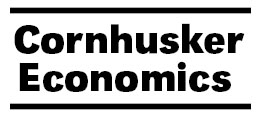Agricultural Economics, Department of

Cornhusker Economics
Date of this Version
7-30-2003
Document Type
Newsletter Issue
Citation
Cornhusker Economics
Abstract
The European Parliament just recently committed the 15-European Union countries to forming a greenhouse gas market trading in carbon equivalents starting January 1, 2005, consistent with each country also ratifying the Kyoto Protocol. Other European countries will also likely be included, for a total of twenty-seven countries. Trading will be among as many as 10,000 to 12,000 industrial and public firms (e.g., electric utilities burning coal) that account for almost one-half the emissions of greenhouse gases in Europe. The precursor to trading will be the setting of emissions caps on 1) each country; 2) on each industry within each country, and; 3) on each firm within each industry. Once the caps are set, then the initial number of European Union Emission Allowance Units (EAUs for short) will be allocated by each country to each of the affected firms within each industry. For example, if the cap on a particular firm is set at 1,000-metric tonnes of carbon equivalent per year, then that firm will be initially assigned 1,000-EAUs or 1-EAU for each 1-metric tonne of allowed emissions. Each firm will then be asked to always keep at least 1-EAU in their investment portfolio of EAUs for every metric tonne emitted. Extra EAUs may be held as investments or sold on the market. If emissions in some given year exceed the number of allowances in the portfolio, then extra EAUs have to be purchased on the market, or some other way of covering emissions must be found, such as storing carbon in agricultural land.


Comments
Published in Cornhusker Economics, 07/30/2003. Produced by the Cooperative Extension, Institute of Agriculture and Natural Resources, Department of Agricultural Economics, University of Nebraska–Lincoln.
http://www.agecon.unl.edu/Cornhuskereconomics.html